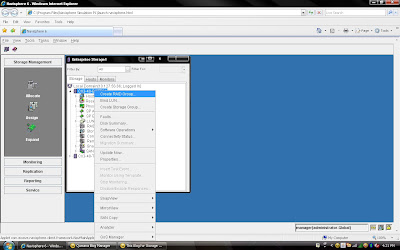Single-initiator zoning rule :--Each HBA port must be in a separate zone that contains it and the SP ports with which it communicates. EMC recommends single-initiator zoning as a best practice.Fibre Channel fan-in rule:--A server can be zoned to a maximum of 4 storage systems.Fibre Channel fan-out rule:-The Navisphere software license determines the number of servers you can connect to a CX3-10c, CX3-20c,CX3-20f, CX3-40c, CX3-40f, or CX3-80 storage systems. The maximum number of connections between servers and a storage system...
What is “Tier 0” in Storage Environments?
Tier "0" is not new in storage market but for implementation purposes it has been difficult to accommodate because it requires best performance and lowest latency. Enterprise Flash disks (Solid State Disks) capable to meet this requirement. It is possible to get more performance for company most critical applications. The performance can be gained through using Flash drives supported in VMAX and DMX-4 systems. Read More →
Showing posts with label CLARiiON. Show all posts
Showing posts with label CLARiiON. Show all posts
LUN to bind Restrictions and recommendations ----------- Any LUN You can bind only unbound disk modules. All disk modules in a must have the same capacity to fully use the modules' storage space. --- In AX-series storage systems, binding disks into LUNs is not supported. RAID 5 - You must bind a minimum of three and no more than sixteen disk modules. We recommend you bind five modules for more efficient use of disk space. In a storage system with SCSI disks, you should use modules...
The global reserved LUN pool works with replication software, such as SnapView, SAN Copy, and MirrorView/A to store data or information required to complete a replication task. The reserved LUN pool consists of one or more private LUNs. The LUN becomes private when you add it to the reserved LUN pool. Since the LUNs in the reserved LUN pool are private LUNs, they cannot belong to storage groups and a server cannot perform I/O to them.Before starting a replication task, the reserved LUN pool must contain at least one LUN for...
AX150 :-Dual storage processor enclosure with Fibre-Channel interface to host and SATA-2 disks. AX150i :-Dual storage processor enclosure with iSCSI interface to host and SATA-2 disks. AX100 :- Dual storage processor enclosure with Fibre-Channel interface to host and SATA-1 disks.AX100SCSingle storage processor enclosure with Fibre-Channel interface to host and SATA-1 disks.AX100iDual storage processor enclosure with iSCSI interface to host and SATA-1 disks.AX100SCiSingle storage processor enclosure with iSCSI interface to...
We have storage array product from different vendor. Everyone talkes about active-active and active-passive device technology. With different types of storage arrays and host connection types, it is important to understand the difference between active-active and active-passive devices. Here is short explanation of the differences:Active-active (for example, Symmetrix arrays)In an active-active storage system, if there are multiple interfaces to a logical device, they all provide equal access to the logical device. Active-active...
If you have a multihomed host and are running like :· IBM AIX,· HP-UX,· Linux,· Solaris,· VMware ESX Server (2.5.0 or later), or· Microsoft Windowsyou must create a parameter file for Navisphere Agent, named agentID.txtAbout the agentID.txt file:This file, agentID.txt (case sensitive), ensures that the Navisphere Agent binds to the correct HBA/NIC for registration and therefore registers the host with the correct storage system. The agentID.txt file must contain the following two lines:Line1: Fully-qualified hostname of the...

CLARiiON Lab Exercise-IIOnce again welcome to CLARiiON Lab Exercise II. Today I will be demonstrating about RAID Group creation and LUN binding on CX Frame. we have understand the storage allocation using Allocation Wizard। But some times host is not registered on HBA is not logged in। Then you can not run the storage allocation wizard. It will fail to allocate storage. Then you need to do step by step. So, First step is create RAID Group...
About Me

- Diwakar
- Sr. Solutions Architect; Expertise: - Cloud Design & Architect - Data Center Consolidation - DC/Storage Virtualization - Technology Refresh - Data Migration - SAN Refresh - Data Center Architecture More info:- diwakar@emcstorageinfo.com
Blog Disclaimer: “The opinions expressed here are my personal opinions. Content published here is not read or approved in advance by EMC and does not necessarily reflect the views and opinions of EMC.”


